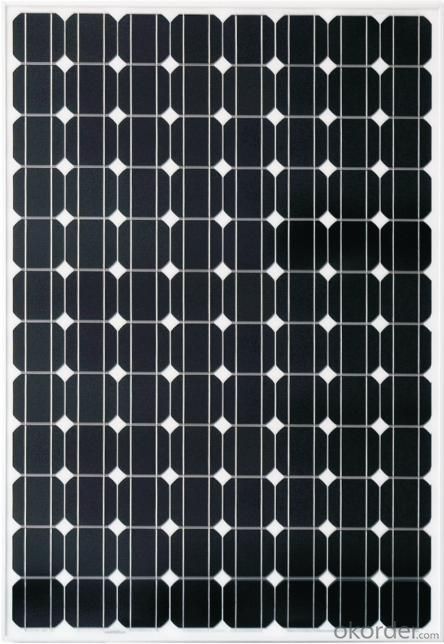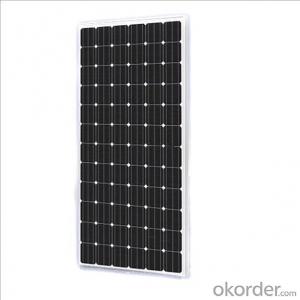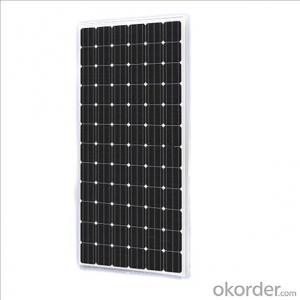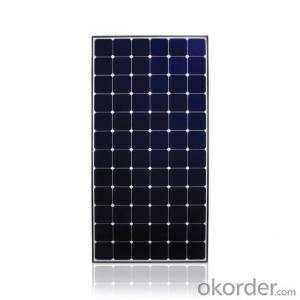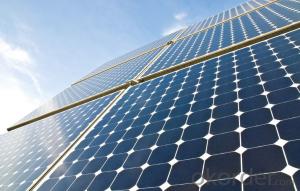Solar Panels for Sale in Houston - Monocrystalline Solar Module 270w
- Loading Port:
- China Main Port
- Payment Terms:
- TT OR LC
- Min Order Qty:
- -
- Supply Capability:
- -
OKorder Service Pledge
OKorder Financial Service
You Might Also Like
Solar Monocrystalline (210W-225W)
Introduction of Solar Monocrystalline (210W-225W)
Solar modules use light energy (photons) from the sun to generate electricity through the photovoltaic effect. The majority of modules use wafer-based crystalline silicon cells or thin-film cells based on cadmium telluride or silicon. The structural (load carrying) member of a module can either be the top layer or the back layer. Cells must also be protected from mechanical damage and moisture. Most solar modules are rigid, but semi-flexible ones are available, based on thin-film cells. These early solar modules were first used in space in 1958.
CNBM Solar photovoltaic (PV) Panel is designed for large electrical power requirements. It is the optimal choice for both on-grid and off-grid power systems. CNBM Solar panel offers high performance of power per square foot of solar array. Monocrystalline silicon(c-Si): often made using the Czochralski process. Single-crystal wafer cells tend to be expensive, and because they are cut from cylindrical ingots, do not completely cover a square solar cell module without a substantial waste of refined silicon. Hence most c-Si panels have uncovered gaps at the four corners of the cells.
Characteristics of Solar Monocrystalline (210W-225W)
I. Solar Cell : High efficiency crystalline solar cell. Even if under the weak light, the solar module can produce maximum power output.
II. Tempered glass (toughened glass): Anti-reflecting coating and high transmission rate glass increase the power output and mechanical strength of solar module.
III. EVA and TPT: Using high quality EVA and TPT to prevent destroying and water.
IV. AI frame: Without screw, corner connection. 6 holes on the frame can be installed easily.
V. Junction box: Multi function junction box with water proof.
VI. Long lifetime: ≥25 years; Less power decrease.
VII. Good performance of preventing from atrocious weather such as wind and hails.
VIII. Resisting moisture and etching effectively, not effected by geology.
IX. The certificate issued by international authority: UL, TUV, IEC, VDE, CE.
Standard Test Conditions of Solar Monocrystalline (210W-225W)
The opto-electrical specifications shown below are stabilized values being measured at Standard Test Conditions, Irradiance: 1000W/m2, Spectrum: AM1.5 at 25°C, The info below is subject to manufacturing tolerances. Where appropriate minutes of measurement are available and are used for the dimensioning of the installation.
Advantages of Solar Monocrystalline (210W-225W)
• CNBM Solar performance guarantees for 25 years
• 10 years guarantee for workmanship
• Timeliness of delivery
• Quality Products certified (TÜV, UL, CE, VDE, ISO)
CNBM International Corporation's products including Monocrystalline Solar Panel, Polycrystalline Solar Panel have received and enjoyed famous reputation in many countries and regions in the world .As a solar panel manufacturer in China, we strive to provide our customers with excellent service, superior products and unmatched value.
- Q: What is the efficiency of modern solar panels?
- The efficiency of modern solar panels typically ranges between 15% and 22%, with some high-end panels reaching efficiencies of up to 23-24%. However, it is important to note that efficiency can vary depending on factors such as the brand, technology used, and environmental conditions.
- Q: Can solar panels be installed on a retirement home or assisted living facility?
- Yes, solar panels can be installed on a retirement home or assisted living facility. In fact, many such facilities are embracing solar energy as a sustainable and cost-effective solution. Installing solar panels can help reduce energy costs, decrease reliance on the grid, and contribute to a greener environment, all while providing clean energy for the residents.
- Q: Single crystal solar panels and polycrystalline solar panels
- Monocrystalline silicon solar cells are mainly made of monocrystalline silicon, compared with other types of solar cells, monocrystalline silicon cell conversion efficiency of the highest. In the early days, monocrystalline silicon solar cells occupied most of the market share, in 1998 after the retreat of polysilicon, the market share accounted for second. Due to the shortage of polysilicon raw materials in recent years, after 2004,
- Q: Which is more efficient at producing energy? Reference(s) would be nice, but not required.
- Depends on the planet and solar panel. Generally, solar panels are more efficient according to these figures I bumped into. Photosynthetic efficiencies range from 0.% - 8%!
- Q: how efficient are flexible solar panels?
- One I got about 3 years ago is about 50% as efficient as a glass panel I got about 0 years ago. Not exactly a scientific study, I know.
- Q: Can solar panels be installed on metal roofs?
- Yes, solar panels can be installed on metal roofs. In fact, metal roofs are considered to be one of the best types of roofs for solar panel installation due to their durability, longevity, and ease of installation. The metal roof provides a stable and secure base for mounting the panels, ensuring optimal energy production. Additionally, the smooth surface of metal roofs allows for efficient panel placement, maximizing sunlight absorption.
- Q: so i told my dad to buy solar panels and he wants to see how much money u can save we pay $00 and i dont want quot;You don't need solar panelshow much would my fmaily save?
- maybe you ought to ask a solar installer in your area. who knows what the electric rates are. and how much electricity you use. and how much sun there is. and what your electric utility's policy is. and what kind of house you have, and how you use electricity. and what appliances (eg stove) you might convert to electric to take advantage of solar panels. wouldn't that seem to be a good idea?
- Q: What, if any, improvement in efficiency per square foot or meter is realized by a solar panel in space vs. being mounted on the ground where the light is attenuated by the atmosphere?In passing, I found a site that gives an output of .89 watts / 4 in. sq for a particular home-mounted panel.
- Solar panels on spacecraft are a lot more efficient than ones made for home use. That doesn't include the effect of the atmosphere.
- Q: I am in need of solar panels and the batteries that I can store the energy in. I need to be able to run a laptop, cell phone, and LED lights from it. When I research I see all sorts of options with regards to watts, VMPs, and AMPs. I also see that I may need a controller, an inverter, and various other components. Can anyone help me through these terms and what i need to know in order to efficiently generate and store the electricity. Thanks
- Okay well solar panels only work under sunlight and it saves alot of electricty as compared to your normal switches.And it also saves money=D.One thing though...it only works under sunlight...remember this fact. Power storage simply means a device which can store power. Well a generator stores power and a power station too!! Otherwise they can't flow through our electric current..... So for power usage simply is like on the fan/lights/mobile/computers/modems/e.t.c are considered as power usage as you are using the power=P Well hope this information helps you!
- Q: I don't see much solar panels on people's houses where I live. I got a long time to go before doing so but I was planning on buying a few solar panels when I retire in the far future. In your opinion, is such an investment worth it? Would you buy them? I realize they are very expensive hence why I said when I retire. Thanks for your opinion
- The payback is usually between about 5 and 5 years depending on how expensive electricity is in your area, the rebates available, and where you live (is it sunny most of the time?) Most people that get them don't do it for the investment - they do it to be energy responsible - but it's not a bad way to do both if you have the money to put into it. I personally just pay for the green energy option from my electricity provider. So I am buying power from solar and wind farms, and it cost about 0% more per month. I don't get the benefit of free power, but it comes with a smaller price tag initially, and I think when we all invest in these technologies, the price will improve over time, so energy costs will be lower in the future.
Send your message to us
Solar Panels for Sale in Houston - Monocrystalline Solar Module 270w
- Loading Port:
- China Main Port
- Payment Terms:
- TT OR LC
- Min Order Qty:
- -
- Supply Capability:
- -
OKorder Service Pledge
OKorder Financial Service
Similar products
Hot products
Hot Searches
Related keywords

